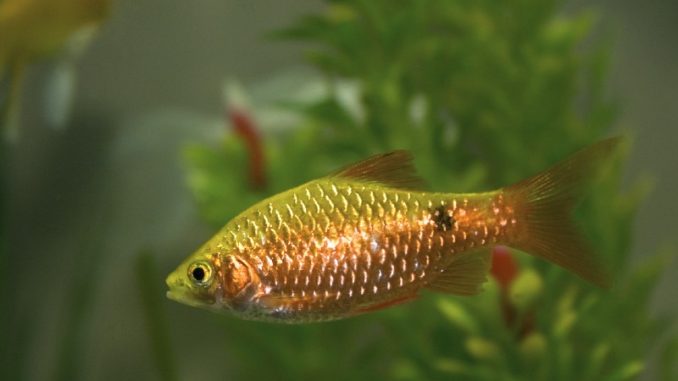
Gold Barbs are a species of barb fish that are sure to brighten up your aquarium. They dazzle with their colors and shoaling behaviors, leaving you transfixed on your fish tank.
What makes them even more popular is their ease of care. Beginner aquarists will enjoy their hardy nature and simple needs, so don’t be worried if you’re new to the hobby.
This article will cover everything you need to know when caring for Gold Barbs. We will cover things like their preferred environment, their diet, and even how to breed them…
TABLE OF CONTENTS
Gold Barb Facts & Overview
| Category | Rating |
| Care Level: | Easy |
| Temperament: | Peaceful |
| Color Form: | Gold with black spots |
| Lifespan: | 5-7 years |
| Size: | Up to 3 inches |
| Diet: | Omnivore |
| Family: | Cyprinidae |
| Minimum Tank Size: | 20 gallons |
| Tank Set-Up: | Tropical freshwater with live plants |
| Compatibility: | Peaceful community |
The Gold Barb, Chinese Barb, or Schuberti Barb a popular freshwater fish in the Cyprinidae family, where it is scientifically known as Barbodes semifasciolatus.
This family contains many aquarium favorites, such as Danios, Rasboras, Goldfish, and fellow Barbs. Other famous members include carps and minnows.
Gold Barbs are native to the Red River basin of the Hong River which flows through Asia from Southwest China to Vietnam.
Here you would find green individuals; this is their natural color. The gold-colored variety in the aquarium trade comes as a result of selective breeding in captivity.
Their captive colors make them particularly attractive for aquarists, but the gold would stand out in their natural environment, putting them at risk of predation.
Unfortunately, numbers are decreasing in the wild due to damage to their natural habitat.
Gold Barbs are a hardy species that will thrive in beginner aquariums, even if small mistakes are made. Their ease of care and bright colors make them popular among experienced aquarists too.
You will be able to find them quite easily in pet stores thanks to their popularity. They will be quite cheap too, costing roughly $3 to $4.
Buying new fish is an easy way to spread disease to your aquarium, so check any fish that you intend to buy for any common problems, like white spots, wounds, or a loss of color.
Shop elsewhere if you think something is wrong with the fish.
Typical Behavior
When thinking about compatibility, Gold Barbs are peaceful fish. They get on well with other peaceful fish that won’t want to eat them.
Perhaps their most important behavior is shoaling. They naturally stay in a group with others of their own kind, as a way of keeping safe.
You should always keep them in a group to keep stress levels at a minimum. The larger the group, the more confident they will feel.
A shoal can take up a lot of space, so be sure to leave plenty of open swimming areas.
They spend most of their time in the lower and middle areas of the tank, though they will head upwards when expecting food.
Appearance
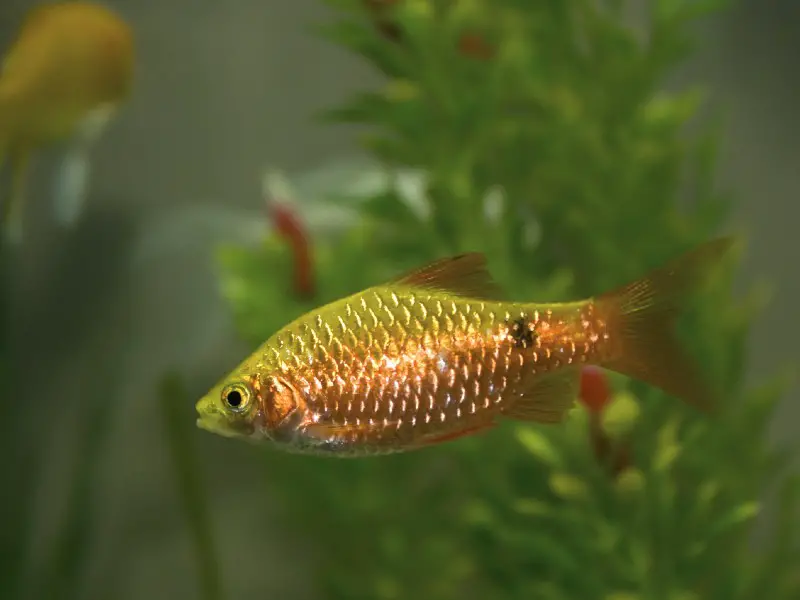
Their name isn’t very subtle regarding their appearance. Gold Barbs are gold, or the ones you will find in a pet store are anyway. They are naturally green in the wild.
Your fish will be almost entirely gold, the only disruptions are small black patches dotted along the lateral line and upper half of their body. Sometimes these appear as vertical bars.
The rest of their 3-inch body is solid in color, except the tips of their fins are slightly see-through. Some stocks are bred with red fins.
If you are willing to spend longer searching for specific stocks, you can find an even more diverse range of Gold Barbs, such as albino varieties. These will cost more though.
On their head is a mouth that angles backward with short barbels at the corners. Just behind the mouth is a large black eye on each side.
Since captive Gold Barbs look different from wild ones, they were originally thought to be different species (the captive variety being known as Puntius semifasciolatus var. schuberti), but it is now confirmed that they are both the same species.
Females are usually larger with a rounder belly. They tend to be duller in color too. Males preparing to mate may develop red bellies.
Habitat and Tank Conditions
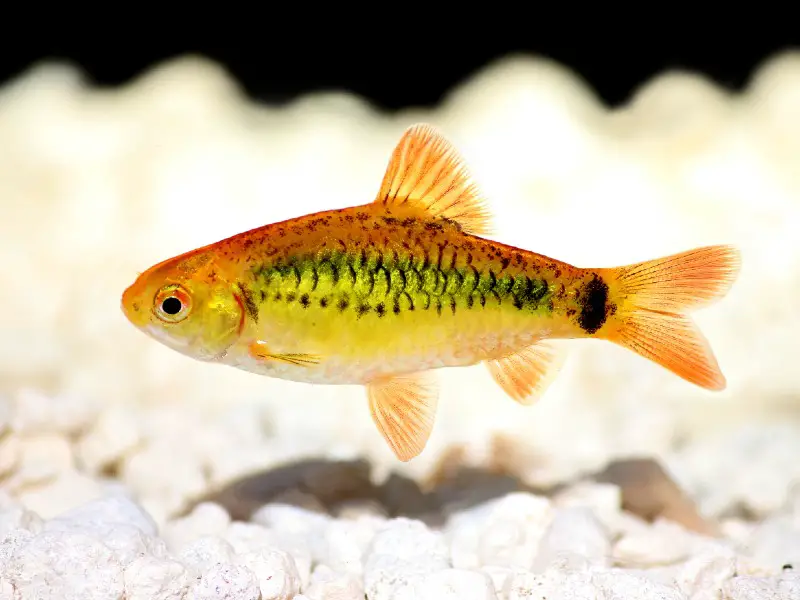
Gold Barbs are naturally found in the freshwater Red River basin of the Hong River in Southeast Asia. You should model your aquarium around this environment to keep them as happy and healthy as possible.
This is easy to do.
The water pH here can range on either side of neutral depending on where the wild population is found. Similarly, the temperature can vary, but they need a heated tank.
These fish are a shoaling species, so they swim together in open water. However, there would be plenty of vegetation for them to retreat to.
They stick to the shallows where there is ample access to light and a light current.
Tank Conditions
Starting with the floor of the tank, use a fine-grained soft substrate to layer the bottom. Gold Barbs will often venture here, and gravels can scratch.
When designing the middle levels of the tank, you need to consider the number of live plants and how much open swimming space you leave.
Both of these are important, for things like shelter and shoaling behaviors respectively.
You can pick multiple plant species that occupy different areas of the tank, such as grasses for the lower levels and long-stemmed plants that will stretch upwards.
Maintain a pH between 6.0-8.0 and a temperature between 64°F and 75°F.
Standard aquarium lighting will be fine, and you shouldn’t need an air/water pump to create a current. This means that a filter and heater are the only essentials.
What Size Aquarium do they need?
Though they are quite small, their active and social nature means they need lots of freedom to move around. A small group of 5-6 will need at least 20 gallons.
The more space you can give them, the happier they will be.
How Many Can be kept per gallon?
Shoaling fish enjoy being kept in the biggest groups possible. Try to provide 3-5 gallons for each additional Gold Barb. Again, more space is always better.
Tank Mates
A peaceful tropical community aquarium is the perfect setting for Gold Barbs. They are peaceful fish themselves that remain very friendly to tank mates.
Compatibility problems will only arise with boisterous or aggressive tank mates that will regularly pester your barbs. Avoid any fish big enough to eat them too.
There are lots of potential tank mates, but be sure to research each species carefully to check compatibility.
Danios, Tetras, Guppies, Dwarf Gourami, Corydoras Catfish, and Zebra Loaches are just a few examples of the plethora of options available to you.
Small invertebrates are also great tank mates. They make some unique attractions to your aquarium and will be mostly ignored by your Gold Barbs.
Can You Keep Gold Barbs Together?
Absolutely, Gold Barbs should always be kept in a group. They naturally shoal for “strength in numbers”.
This isn’t just a defense mechanism; it also provides plenty of social interaction. Without this, a Gold Barb would become very lonely, leading to stress, disease, and possibly death.
Always keep these fish in groups of at least 5 or 6, but the larger the shoal, the better.
You could keep a single species tank of Gold Barbs, leaving more space for a larger shoal. This will help to show off their bright colors and captivating movements.
Diet
These fish are omnivores, meaning that they will eat vegetation and meaty foods. This means there are so many choices when it comes to designing a diet.
The most important thing is varying what you feed them. This ensures that they get a range of different nutrients from their food, keeping them strong and healthy.
Generally, this means avoiding a diet consisting solely of dried foods, such as flakes and pellets. These lose most of their nutritional value during the manufacturing process.
Mix in live/frozen foods like bloodworms, daphnia, and brine shrimp.
Only give them an amount they can easily finish within 2 minutes. Do this 2-3 times a day. Breaking up feeding like this helps to ease the work on their digestive system.
Care
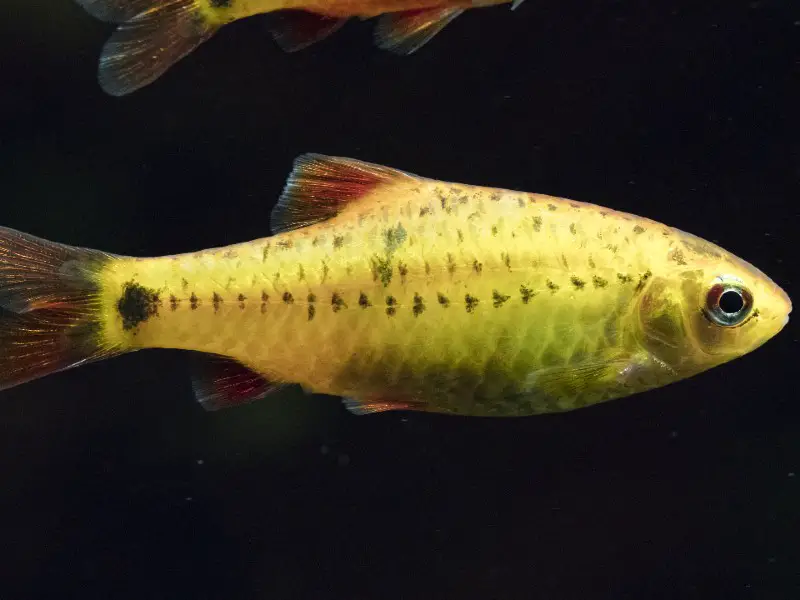
Caring for Gold Barbs is easy, which is why they are a great choice for beginners. They’re peaceful, hardy, and have simple requirements, so they are likely to reach old age at 5-7 years with proper care.
This involves maintaining a clean tank with their preferred water conditions. Clean the aquarium regularly by performing partial water changes and wiping away excess algae.
A good habit to get into is using a water testing kit every week. This will let you spot problems quickly, so you can hopefully respond before the health of your fish is affected.
An unclean tank can lead to disease. Pathogens thrive in poor water conditions.
Gold Barbs are not prone to any particular diseases, so look out for the signs of common pathogens. For example, the parasite “ich” presents as white spots across a fish’s body.
If you spot signs of disease, isolate the afflicted fish in a quarantine tank in an attempt to prevent it from spreading. Treat the fish here until it is safe to be returned to the main aquarium.
Breeding
Breeding Gold Barbs is relatively easy if the conditions of the tank are perfect, so cleaning it properly is essential.
To trigger spawning, you could try gradually increasing the water temperature to 75°F over a few days.
Once ready to spawn, the female will look rounder and the male will develop a red belly.
It is essential that you have lots of live plants in your breeding tank, as these are where your Gold Barbs will spawn and lay eggs.
Once you notice that this has happened, remove the parents from the tank, or else they may eat the eggs.
After a couple of days, the fry will hatch. Feed them liquid fry food or baby brine shrimp until they grow large enough to eat a more adult diet. There are many fry foods available in pet stores.
Are Gold Barbs Suitable for Your Aquarium?
Gold Barbs can be looked after by anyone. Their ease of care makes them excellent beginner fish, but their beauty makes them popular with experienced aquarists too.
Provided the water conditions are within their preferred range, they can go into virtually any tropical aquarium. Just make sure they will only be living with other peaceful species.
Gold Barbs are bright and colorful fish, but also provide plenty of activity, a perfect combo. They look best in large shoals; you’ll be impressed by their exaggerated colors and movements.
Why do you like Gold Barbs in your aquarium? Let us know in the comments below…

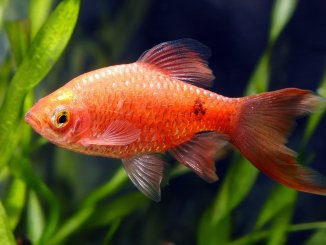

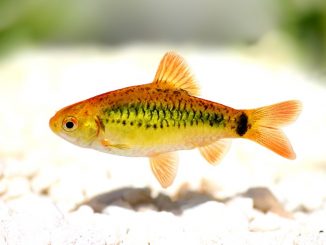
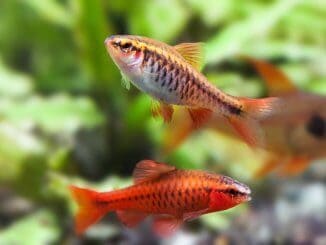
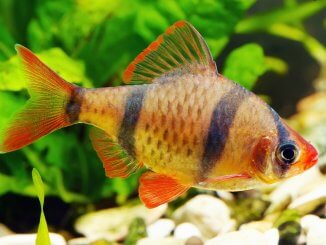
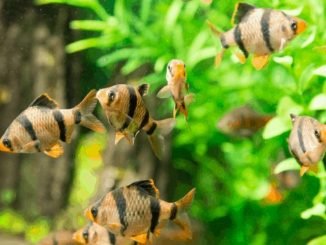
Be the first to comment